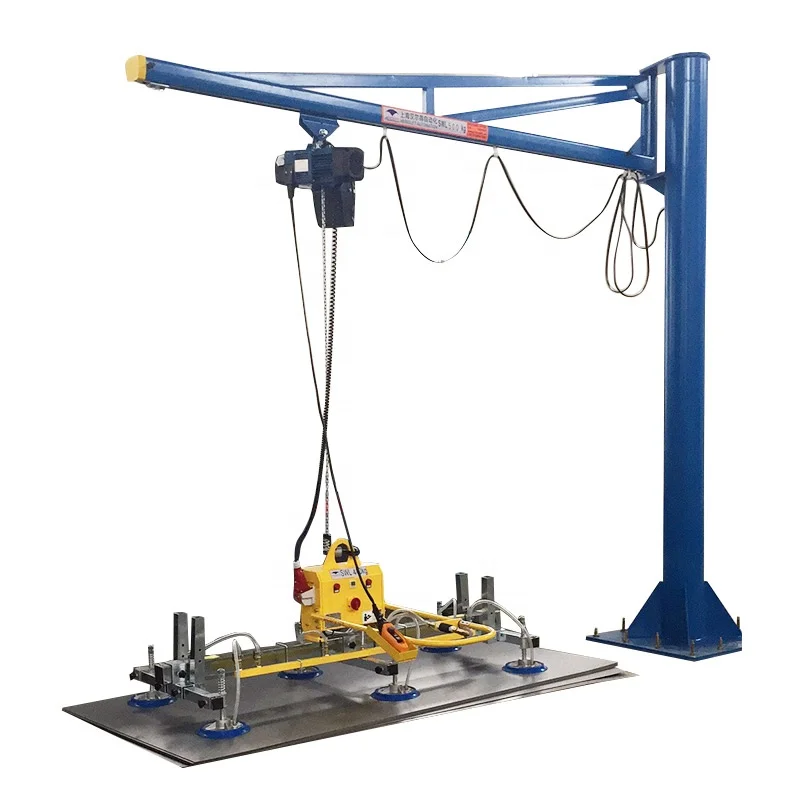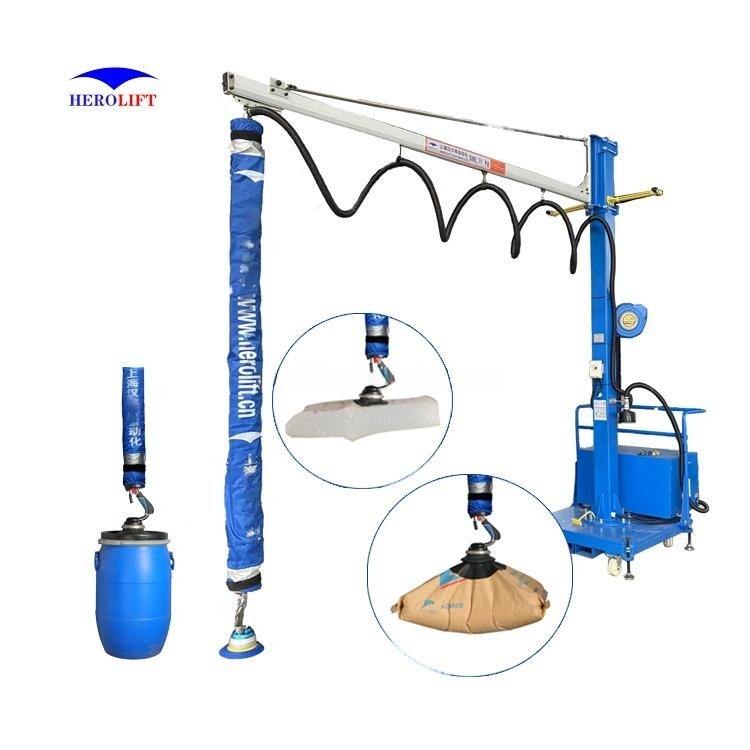Pneumatinių vakuolinio keltuvo ir vamzdynų supratimas: palyginimas su hidrauliniais keltukais
Kurjų apdirbimo ir vertikalo transportavimo sektoriuose pneiginių sistemų dėka jų efektyvumo ir universališkumo gavo didelę dėmesį. Šioje srityje du pagrindiniai komponentai yra pneiginiai vakuumo liftai ir pneiginiai vakuumo vamzdynai. Ši straipsnis ištirs, kaip veikia šios sistemos, jų taikymą ir kaip jos palygintinos su hidrauliniais liftais, kad būtų gana visapusiškos jų gebėjimų supratimo.

Kas yra pneiginis vakuumo lifts?
Pneiginis vakuumo lifts yra įrenginys, naudojantis oro slėgiu, kad pakeltų ir perveiktų sunkias medžiagas. Jis veikia sukurdamas vakuumą, kuris prisideda prie apkrovos paviršiaus, leidžiant saugiai ir efektyviai ją apdoroti. Tokie liftai ypač naudingi pramonės srityse, kur medžiagos yra jautrios ar netinkamos formos, pvz., stiklo, lapo metalo ir pakavimo medžiagų.
Jūrų krovinių keliavimo prietaisas sudarytas iš vakuumo padės, pneumatine vakuumo vamzdyno ir valdymo sistemos. Vakuumo padės sukuria hermetišką jungtį su objekto paviršiumi, o pneumatiniai vakuumo vamzdynai reguliuoja oro srautą, kad palaikytų vakuumą. Sistema leidžia operatoriams kelti ir transportinginti daiktus su minimalia fizinėmis pastangomis, mažinant traumų riziką ir padidindant produktyvumą.
Kaip veikia pneumatinis vakuumo vamzdynas?

Pneumatinis vakuumo vamzdynas yra pagrindinio komponento pneumatiniame vakuumo keliavimo prietaise. Jis valdo oro srautą į ir iš vakuumo sistemos, užtikrinantis, kad vakuumas būtų palaikomas, kol veikia keliavimo prietaisas. Vamzdynas paprastai veikia naudojant mechanizmą, kuris atverčia ir užverčia pagal slėgio skirtumą, kurį sukuria vakuumas.
Kai pagardas yra įjungtas, vamzdynas atverčiasi, leidžiant oro išsiskilti iš vakuumo padės, kuris sukuria neigiamą slaptį, kad saugiai palaikytų daiktus. Kai daiktas yra pakeltas, vamzdynas gali būti sutvarkytas, kad palaikytų vakuumą arba jį išleistų, kai reikia žeminti teršę. Toks tikslus valdymas yra kritinis saugumo ir pakelimo proceso efektyvumui užtikrinti.
Pneumatinių vakuumo pakelio ir hidraulinio pakelio
Pneumatinių vakuumo pakeliai yra sukurti medžiagų apdirbtiems procesams, o hidrauliniai pakeliai turi kitokį tikslą: vertikaliai transportuoti žmones ir prekes pastate. Supratimas apie šių dviejų sistemų skirtumus gali padėti aiškiai suprasti jų atskiras programines priemones ir privalumus.
1. Veikimo mechanizmas:
- Pneumatiniai vakuumo pakeliai: Šie įrenginiai remiasi oro slėgiu ir vakuumo technologija, kad pakeltų daiktus. Vakuumas yra sukurtas išvalydami orą iš uždaro erdvės, leidžiant pakeliui prisijungti prie terpės.
- Hidraulinis kabinas-: Priešingai, hidraulinis kabinas naudoja hidraulinį aliejų, kad paaugintų šoninę viršūnę viduje cilindro. Kai skysčio yra įpumpuojama į cilindrą, jis pakelia lifto kabina. Sistema dažniausiai yra galingesnė ir gali veikti su sunkesniais krūviais ilgesniuose atstumuose.
2. -Greitis ir efektyvumas-:
- -Gazinis sistemos-: Gaziniai vakuumo liftai paprastai greičiau valdo krūves, nes jie gali greitai prijungti ir atjungti objektus. Šis greitis yra naudingas aplinkose, kur laikas yra svarbus, pvz., gamyboje ir sandėlyse.
- -Hidraulinė sistema-: Hidrauliniai liftai gali turėti lėtesnius pagreitio ir stabdymo tempus, bet jie teikia glodžią veiklą ir gali efektyviau transportuoti didesnius krūves ilgesniuose atstumuose.
3. -Vieta reikalavimai-:
- -Gaziniai kabinai-: Šios sistemos yra paprastai kompaktiškesnės ir gali būti naudojamos mažose vietose, dėl ko jos yra idealios gamykloms ir darbinėms, kuriose vieta yra brangia.
- Hidrauliniai jumtai: Hidraulinės sistemos reikalauja daugiau vietos montuoti hidraulinę riterį ir susijusius komponentus, kas gali apriboti jų naudojimą mažesniuose pastatuose.
4. - Techninė priežiūra ir kainos-:
- Pneumatinių sistemų: Pneumatiniai vakuumo jumtai bendrai turi žemesnes techninės priežiūros išlaidas dėl mažesnio judančių dalių skaičiaus ir negaliojančios reikalingumo hidrauliniam aliejui. Tačiau jie gali reikalauti periodinių inspekcijų, kad būtų užtikrinta vakuumo sigelio tvirtumas.
- Hidraulinė sistema: Hidrauliniai jumtai gali būti brangiau palaikyti dėl hidraulinės sistemos sudėtingumo ir galimybės, kad nuteks hidraulinis skysčio. Tačiau, jei juos tinkamai palaiko, jie yra žinomi dėl savo vargybės ir ilgovo.
5. -Pritaikymas-:
- Pneumatiniai vakuumo jumtai: Jie plačiai naudojami gamyboje, ambalavimo ir logistikos srityse, kur greitas ir saugus medžiagų apdorojimas yra svarbus.
- Hidraulinis jumtas: Hidrauliniai jumtai paprastai randami verslo ir gyvenamose pastatose ir yra puikiai tinka asmenims ir sunkioms medžiagoms transportuoti tarp aukštų.

Apibendrinant
Pneumatiniai vakuumo gilimai ir pneumatiniai vakuumo vamzdynai žaidžia svarbų vaidmenį šiuolaikinėje medžiagų apdirbimo srityje, siūlant efektyvias ir saugas sprendimus keliui ir prekių transportavimui. Nors jie turi tam tikrų panašumų su hidrauliniais liftais, jų veikimo mechanizmai, greičiai, erdviniai reikalavimai ir paskirtys yra visiškai skirtingi. Supratimas jų skirtumų gali padėti įmonėms pasirinkti sistemą, atitinkančią jų specifinius poreikius, kas galiausiai padarytų jų operacijas produktyvesnėmis ir saugesnėmis. Kada pramonė toliau vystosi, poreikis efektyviems kelionės sprendiniams, tokiais kaip pneumatiniai vakuumo gilimai, tikriausiai augs, dėl ko jie taps svarbiaisiais medžiagų apdirbimo pasaulyje dalimi.

 EN
EN
 AR
AR
 HR
HR
 DA
DA
 NL
NL
 FR
FR
 DE
DE
 EL
EL
 IT
IT
 JA
JA
 KO
KO
 NO
NO
 PL
PL
 PT
PT
 RO
RO
 RU
RU
 ES
ES
 SV
SV
 TL
TL
 ID
ID
 LV
LV
 LT
LT
 SR
SR
 SL
SL
 UK
UK
 VI
VI
 HU
HU
 TH
TH
 TR
TR
 AF
AF
 MS
MS
 GA
GA
 BE
BE
 MK
MK
 AZ
AZ
 UR
UR
 EO
EO
 LA
LA
 MN
MN
 KK
KK





















